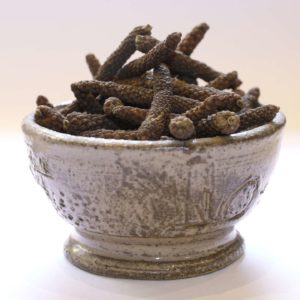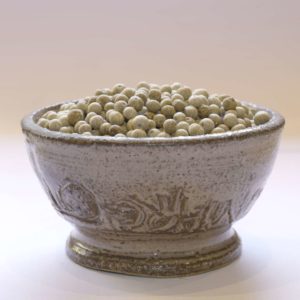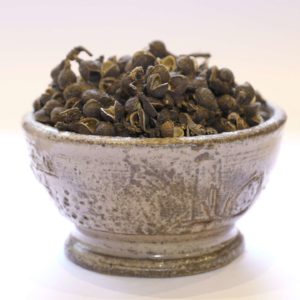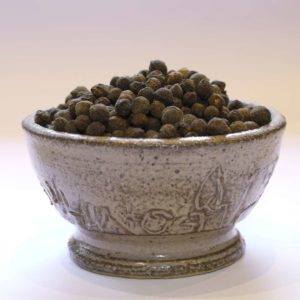0
- ONLINE GROCERY
- OUR HISTORY
- BLOG
- CONTACT
- MY ACCOUNT
- PRO
10,60 €181,00 € /kg
A Chinese zanthoxylum, Sichuan pepper is a false pepper but has all the attributes of the real thing. Not very pungent, it goes perfectly with duck or pork dishes, but also flavors compotes and mixed fruits.
Also known as "clavalier also known as "clavalier", "fagara" or "pepper-flower", it is the dried fruit of a tree typical of Sichuan, a province in southwest China.
Harvested in late summer, before ripening, the berries are sun-dried to a brownish color.
Once roasted, they deliver a woody, slightly acidic flavor, less pungent than black pepper.
This false pepper is used in the famous Chinese 5-spice blend of fennel, cinnamon, aniseed and cloves.
Sichuan (or Sechuan) pepper is a zanthoxylum (false pepper tree) like Batak berries or Timur Bio berries.
These faux peppers have the particularity of being very fruity in taste, with citrus aromas (lemon, grapefruit, tangerine), the Batak berry is also called mandarin pepper.
To find out more, read our article on fake peppers.
Sichuan pepper, also known as Chinese pepper, is a traditional ingredient in Chinese cuisine, and particularly in Sechuanese cuisine.
It is to China what Sancho berry is to Japan (from the Alpha Sanshool amide that gives it its irritating, tingling flavour).
Tibetans use it in their traditional dish, momo, a steamed ravioli made from beef or yak (or cheese/vegetables) flavored with Sichuan pepper, ginger, garlic, onion, coriander and cumin. There are as many recipes in India and Asia as there are families!
Before chillies were imported to China from America, Sichuan pepper and ginger were used to enhance dishes in northern Chinese cuisine.
Many are surprised to learn that Sichuan pepper is not a pepper at all.
It does not come from Piper nigrum, as black pepper (native to India) does, and is not related to chillies (genus Capsicum), native to the Americas.
The ashy shrub species used to produce Sichuan pepper are native to China and Taiwan, and plants are grown in the Himalayan region, Thailand and Indonesia. The name comes from the northern Chinese province of Sichuan, formerly known as "Szechuan" in English.
Pepper from northern China is Z. bungeanum, while that from eastern China and Taiwan is Z. simulans.
The aroma of Sichuan pepper has been compared to that of lavender.
On the tongue, the first taste is bitter, followed by an anesthetizing warmth, then citrus notes.
Its main asset is the powerful numbing sensation it provokes around the mouth.
Sichuan peppercorns contain the molecule hydroxy-alpha-sanshool.
Like capsaicin in chillies, it interacts with nerve cell receptors in the lips and mouth (researchers have identified Meissner receptors).
This excites the tactile sensors and the disconcerting sensation of numbness.
The chemical triggers the receptors, prompting them to send a message to your brain that the area has been touched.
So with enough stimulation, it feels as if the area has become numb.
Recipes often suggest roasting and grinding the pepper. Check the peppercorns carefully and discard the tiny black seeds.
Heat peppercorns in a frying pan over medium-low heat until fragrant.
Remove them from the heat, then grind or crush them when cool.
Toasted peppercorns can also be stored in an airtight jar for grinding as needed in a recipe.
Szechuan pepper is an ingredient in many meat, poultry and noodle dishes.
Ground and roasted, it is used to make infused Szechuan pepper oil.
It is also combined with salt to make a tasty Szechuan peppery salt for use as a condiment with meat dishes.
Botany: Zanthoxylum piperitum (INPN)
Origin: Sichuan, China
Ingredients: 100% Sichuan pepper
Storage: Several years, protected from light and humidity.
Product strength: 5 (Scoville)
| Weight | 50 g |
|---|---|
| Weight | 50g box, 50g pouch, 100g pouch, 200g pouch, 500g pouch |
| Botanical nomenclature | anthoxylum piperitum |
| Color | Dark gray-black |
| Continent-Country | Asia |



